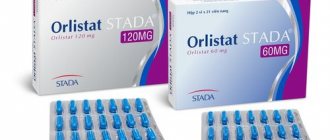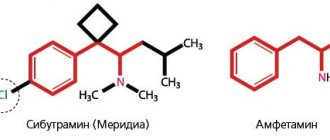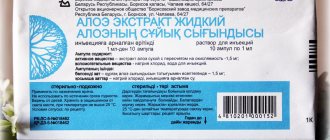Release form and composition
Dosage form - capsules: No. 1, gelatin, turquoise color, with a solid opaque structure and black inscription: “XENICAL 120” on the body, “ROCHE” on the cap; inside the capsules there are almost white or white pellets (21 pieces in blisters, 1, 2 or 4 blisters in a cardboard pack).
The active substance of Xenical is orlistat, 120 mg in 1 capsule.
Excipients: talc.
Auxiliary components of pellets: sodium carboxymethyl starch (Primogel), microcrystalline cellulose, sodium lauryl sulfate, povidone K-30.
Capsule shell composition: indigo carmine, gelatin, titanium dioxide.
Pharmacological properties
Pharmacodynamics
Xenical is a specific, potent and reversible inhibitor of gastrointestinal lipases, characterized by a prolonged effect. Its therapeutic effect is carried out in the lumen of the small intestine and stomach and consists of the formation of a covalent bond with the active serine site of pancreatic and gastric lipases. In this case, the inactivated enzyme loses its ability to break down fats supplied from food in the form of triglycerides into monoglycerides and absorbable free fatty acids. Since triglycerides that have not undergone destruction in the body are not absorbed, fewer calories enter the body, which leads to weight loss. In addition, the therapeutic effect of Xenical is realized without the entry of its components into the systemic circulation.
Fecal fat data suggest that orlistat begins to work 24 to 48 hours after dosing. Discontinuation of the drug results in a decrease in fecal fat concentration to the level recorded before the start of treatment within 48–72 hours.
Clinical studies of patients taking Xenical show that they experienced greater weight loss compared to patients prescribed diet therapy. A decrease in body weight was noted within the first 2 weeks after the start of therapy and lasted 6–12 months even in patients who responded negatively to diet therapy. Over the course of two years, a statistically significant improvement in the profile of metabolic risk factors accompanying obesity was recorded. There was also a significant reduction in body fat compared to placebo.
The use of orlistat helps prevent weight gain. Weight gain, amounting to no more than 25% of the lost weight, was observed in approximately 50% of patients, while the rest maintained the body weight they achieved at the end of therapy (sometimes even a further decrease was detected).
Clinical studies lasting from 6 months to 1 year have convincingly proven that in patients with increased body weight or obesity and type 2 diabetes mellitus who took Xenical, body weight decreases more significantly than in patients who were prescribed only diet therapy as treatment . Weight loss occurred mainly due to a decrease in body fat. Before the start of the study, even in patients taking hypoglycemic drugs, glycemic control was insufficient. However, treatment with orlistat achieved clinically and statistically significant improvements in glycemic control. The therapy also led to a decrease in insulin concentrations, a decrease in doses of hypoglycemic drugs and a decrease in insulin resistance.
The results of studies conducted over 4 years confirm that orlistat significantly reduces the risk of developing type 2 diabetes (by approximately 37% compared to placebo). The degree of reduction in the likelihood of developing the disease was even more significant in patients with initial impaired glucose tolerance (by approximately 45%).
A 1-year clinical study conducted in a group of obese pubertal patients clearly demonstrated a decrease in body mass index in adolescents taking orlistat compared to those receiving placebo alone. Also, patients taking Xenical experienced a decrease in fat mass and hip and waist circumference and a significant decrease in diastolic blood pressure compared to the placebo group.
Pharmacokinetics
In both obese and normal weight patients, the systemic exposure to Xenical is minimized. A single oral dose of 360 mg does not result in the appearance of unchanged orlistat in plasma, indicating that its concentration does not reach the level of 5 ng/ml.
The volume of distribution of orlistat is almost impossible to determine due to poor absorption. In vitro, the compound is more than 99% bound to plasma proteins (mainly albumin and lipoproteins). A small amount of orlistat can penetrate the membrane of red blood cells.
Metabolism of orlistat occurs primarily in the intestinal wall. Experiments have shown that approximately 42% of the minimal fraction of Xenical exposed to systemic absorption consists of two main metabolites: M1 (four-membered hydrolyzed lactone ring) and M3 (M1 with a cleaved N-formylleucine segment).
The M1 and M3 molecules contain an open β-lactone ring, and they also inhibit lipase very slightly (1000 and 2500 times weaker than orlistat, respectively). These metabolites are considered pharmacologically inactive due to low inhibitory activity and minimal plasma concentrations (approximately 26 ng/ml and 108 ng/ml, respectively) when taking Xenical in small doses.
The main route of elimination involves excretion of unabsorbed orlistat in the feces. Approximately 97% of the administered dose of Xenical is excreted in the feces, with about 83% unchanged. The total renal excretion of all substances whose structure is related to orlistat is less than 2% of the oral dose. The period of complete elimination of the drug from the body (with urine and feces) is 3–5 days. The ratio of the routes of elimination of the active component of Xenical in people with normal body weight and in obese patients turned out to be the same. Orlistat and its metabolites M1 and M3 can also be excreted in the bile. Their concentrations in plasma during the treatment of children do not differ from those in adult patients when taking the same doses of the drug. Daily excretion of fat in feces during treatment with Xenical was 27% when taking the drug with food and 7% when taking placebo.
Preclinical data and animal studies indicate no additional risks to patients regarding safety profile, toxicity, reproductive toxicity, genotoxicity or carcinogenicity. It has also not been proven to have a teratogenic effect in animals, making it unlikely to occur in humans.
The result of modern nutrition is depressing
The result of the modern Western diet is very clear: fructose and other carbohydrates lead to excess body fat , the development of obesity and health problems. In addition, no amount of physical exercise (you can work out in the gym for at least 10 hours a day) can compensate for this damage to health because if you eat extra carbohydrates that were not inherent in the diet of our ancestors, then these carbohydrates activate the systems body for your body to store fat.
A radical reduction in carbohydrate intake and bringing healthy fats to 50-70% of the diet will lead to a much healthier body and significant weight loss.
It's helpful to remember that fat is a much more filling food than carbohydrates, so if you're reducing carbohydrates in your diet and find yourself hungry, it's a sign that you haven't replaced fats with enough healthy fats.
Some sources of healthy fats:
- Olives and extra virgin olive oil (only in a very dark glass bottle) – for cold dishes
- Coconuts and coconut oil - for dishes at any temperature
- Butter from free range animals
- Raw (not roasted or salted) nuts, such as almonds or pecans
- Egg yolks from free-range poultry
- Avocado
- Uncooked nut butters
- Fish
- Meat from free range animals
Information sources
- www.ncbi.nlm.nih.gov
- www.fda.gov
- www.fda.gov
- www.fda.gov
The information on this site has not been evaluated by any medical organization. We do not seek to diagnose or treat any disease. The information on the site is provided for educational purposes only. You should consult your physician before acting on information from this site, especially if you are pregnant, nursing, taking medications, or have any medical condition.
Rate this article
Average 5 Total votes (2)
Instructions for use of Xenical: method and dosage
Capsules are taken orally, during or immediately (within 1 hour) after meals.
Recommended dosage: 1 capsule 3 times a day, during each main meal.
If the food does not contain fats or the patient skips breakfast, dinner or lunch, then the daily dose of the drug is reduced by the number of meals missed.
The patient's balanced, moderately low-calorie diet should contain up to 30% fat. The daily calorie intake, consisting of fats, proteins and carbohydrates, should be divided into three main meals.
Contraindications to the use of Xenical
Xenical is contraindicated for pregnant and lactating women, people with pancreatic diseases, and people who have recently undergone serious surgery on the stomach and intestines.
The drug is contraindicated in patients with cholestatic syndrome and chronic malabsorption syndrome. Since the drug affects cholesterol and insulin levels, if the patient is taking medications to increase or decrease them, the doctor must know about this in order to adjust the dosage.
Some drugs and Xenical may interact with each other. Among these medications:
- cyclosporine and other drugs that prevent transplant rejection;
- amiodarone and other medications prescribed for arrhythmias;
- warfarin and other anticoagulants;
- vitamin supplements;
- other drugs for weight loss.
Side effects
During clinical studies of the use of Xenical, the following adverse reactions occurred:
- From the gastrointestinal tract: very often - strong urge to defecate, discharge from the rectum of an oily structure, steatorrhea, release of gases with insignificant discharge, increased frequency of bowel movements, loose stools, discomfort or pain in the abdomen, flatulence (frequency increases with increasing fat content in food); often - bloating, soft stools, fecal incontinence, pain or discomfort in the rectum, damage to teeth and/or gums;
- Other: very often - headache, upper respiratory tract infection, flu; often - weakness, dysmenorrhea, anxiety, urinary and lower respiratory tract infections, in patients with type 2 diabetes mellitus - hypoglycemic conditions.
Post-marketing observations describe possible cases of side effects:
- Allergic reactions: rarely - itching, skin rash, bronchospasm, urticaria, anaphylaxis, angioedema; very rarely - bullous rash;
- Other: very rarely - increased activity of alkaline phosphatase and transaminases, hepatitis, rectal bleeding, diverticulitis, pancreatitis, cholelithiasis and oxalate nephropathy (frequency unknown).
Overdose
Clinical studies involving individuals with normal body weight and obese patients who took a single dose of 800 mg or were treated with Xenical for 15 days and received it at a dosage of 400 mg 3 times a day did not confirm the occurrence of significant adverse events. Also, patients taking orlistat 240 mg 3 times a day for 6 months did not experience significant health problems.
Thus, in case of an overdose of Xenical, adverse events are either absent or similar to those recorded when using the drug in therapeutic doses. In case of severe overdose of the drug, it is recommended to monitor the patient's condition for 24 hours. According to animal and human studies, all systemic effects associated with the lipase inhibitory properties of orlistat are quickly reversible.
Who is it prescribed to?
The drug is prescribed by gastroenterologists and nutritionists to overweight and obese patients.
To correct body weight, the nutritionist also prescribes a diet in which the effect of Xenical will be most effective.
The medicine is also taken for prophylactic purposes, if there are no contraindications for use.
special instructions
According to the instructions, Xenical, with long-term use, allows you to control the reduction and maintenance of body weight at a new level, preventing the re-gain of extra pounds.
Exceeding the recommended dose of orlistat does not enhance its therapeutic effect.
The clinical effect of the drug reduces the amount of visceral fat and improves the profile of risk factors and pathologies associated with obesity, including impaired glucose tolerance, type 2 diabetes mellitus, hyperinsulinemia, hypercholesterolemia, arterial hypertension.
Simultaneous administration of the drug with hypoglycemic agents (sulfonylurea derivatives, metformin, insulin) and adherence to a moderately low-calorie diet allows patients with type 2 diabetes mellitus with obesity or overweight to further improve the compensation of carbohydrate metabolism.
In most patients, after four years of using orlistat, clinical studies confirm the content of betacarotene and vitamins A, D, E, K within normal limits. To provide the body with an adequate supply of nutrients, the prescription of multivitamins is indicated.
A moderately low-calorie diet should be balanced, containing plenty of fruits and vegetables and 30% or less of calories from fat. The daily intake of carbohydrates, fats and proteins should be eaten in three main meals.
The likelihood of side effects of the drug from the gastrointestinal tract increases against the background of foods rich in fat.
The use of Xenical for type 2 diabetes mellitus improves the compensation of carbohydrate metabolism and may require a reduction in the dose of hypoglycemic agents.
Drug interactions
No clinical interaction of Xenical has been identified with the simultaneous use of amitriptyline, atorvastatin, biguanides, digoxin, fibrates, fluoxetine, losartan, phenytoin, oral contraceptives, phentermine, pravastatin, warfarin, nifedipine gastrointestinal therapeutic system and slow-release nifedipine, sibutramine or alcohol consumption. However, when combined with oral anticoagulants, including warfarin, it is recommended to monitor the international normalized ratio (INR).
There is a decrease in the absorption of betacarotene and vitamins D, E, so multivitamins should be taken before bed or 2 hours after taking the drug.
Combination with cyclosporine may lead to a decrease in its plasma concentration, therefore it is necessary to regularly determine the plasma level of cyclosporine when combined with orlistat.
Due to the lack of pharmacokinetic studies, concomitant use of acarbose is contraindicated.
During the simultaneous use of Xenical and antiepileptic drugs, cases of seizures developing in the patient were recorded. Since the cause-and-effect relationship of this interaction has not been established, the frequency and/or severity of seizures in this category of patients should be monitored.
Reviews of Xenical
According to reviews, Xenical causes ambiguous attitudes among patients. Most of them claim that its use will be effective only in the case of a comprehensive fight against the problem of excess weight.
Many doctors consider the drug to be a good aid in the treatment of obesity, but its use must be combined with a low-fat diet. Over the course of 1 month of treatment with Xenical, even without significant strength and physical activity, you can lose 1.5-2 kg. Even better results are achieved by combining such drug therapy with sports.
Depending on the individual characteristics of the body and the thoroughness of compliance with the doctor’s instructions, it is possible to reduce body weight by 10-15 kg in 3 months, and by 30 kg in 6 months.
Indications
Xenical is a real weight loss medicine that has medical indications for taking:
- obesity;
- excess body weight;
- concomitant diseases caused by obesity: diabetes mellitus, hypertension, metabolic disorders;
- taking hypoglycemic drugs.
If you need to get rid of 3-4 kg in a week, Xenical will not suit you. It is recommended for those who need to lose quite a lot of weight, without limiting themselves in time. Yes, the process will take a long time, but there will be no need to put the body into a state of stress through express diets, and the skin will not sag in folds as a result of rapid weight loss. Everything will go quite smoothly. But only if the rules of admission are followed and contraindications are taken into account.
Useful list. Xenical is a component of complex therapy and can be prescribed to enhance the effectiveness of hypoglycemic drugs: Glibenclamide, Gliclazide, Gliquidone, Glimepiride, Chlorpropamide, Glipizide, Acarbose, Miglitol, Nateglinide, Repaglinide, Phenformin, Metformin, Buformin, Pioglitazone, Rosiglitazone, Ciglitazone, Englitazone, Troglitazone , incretin mimetics.









